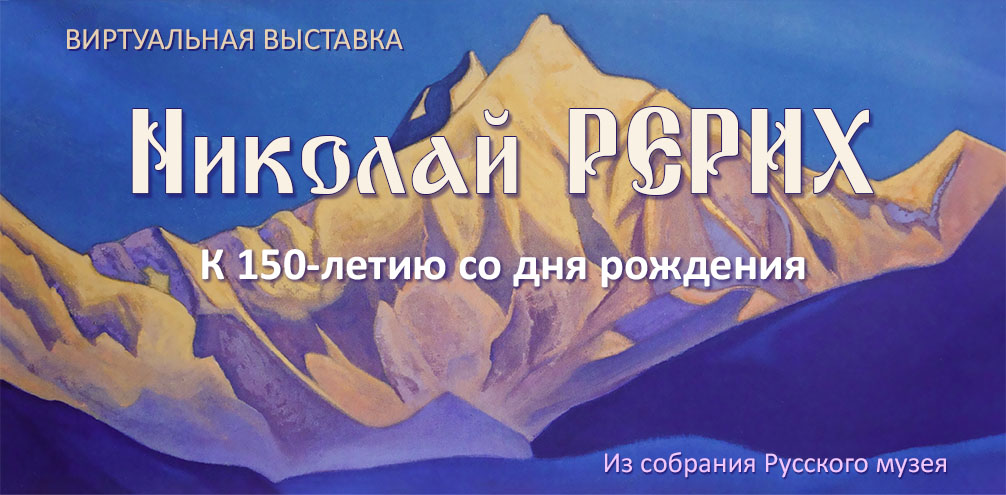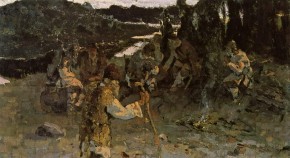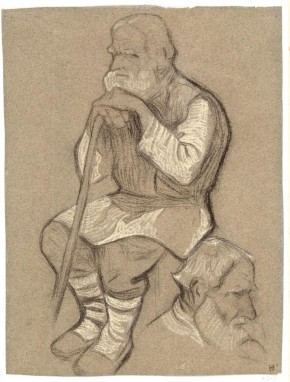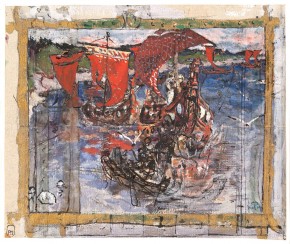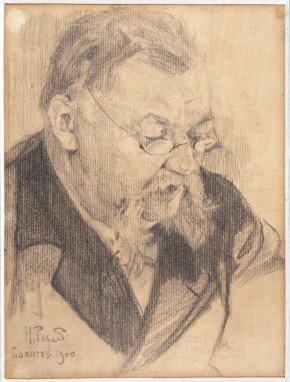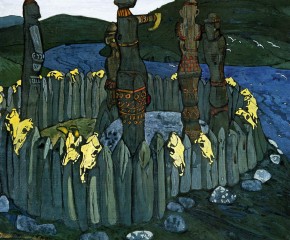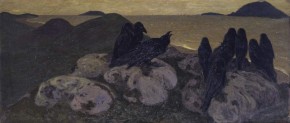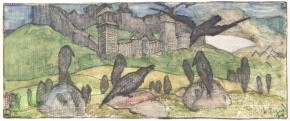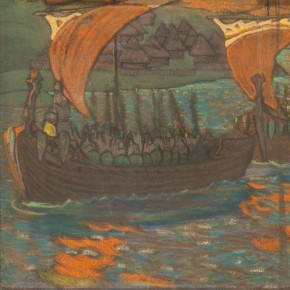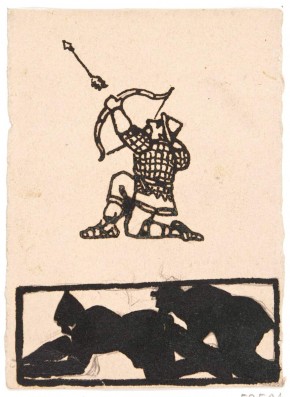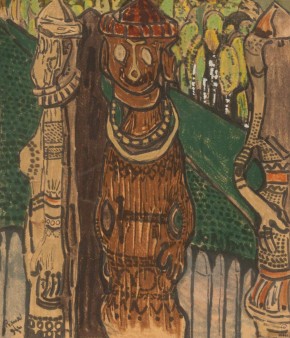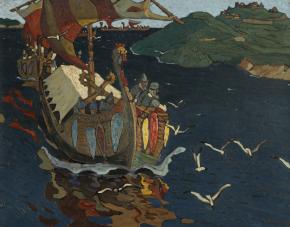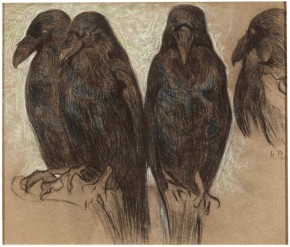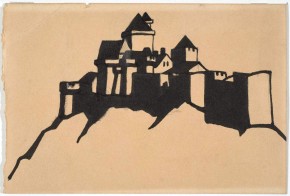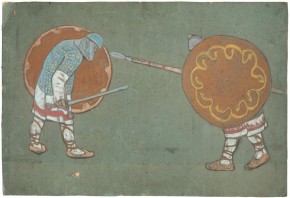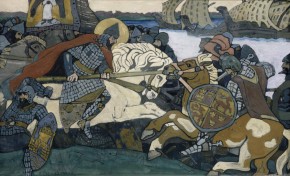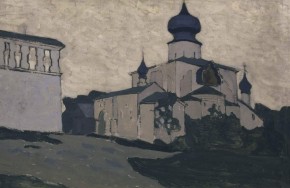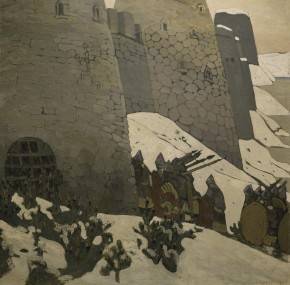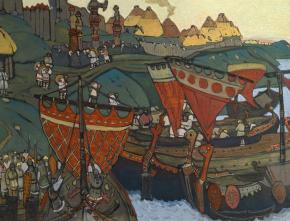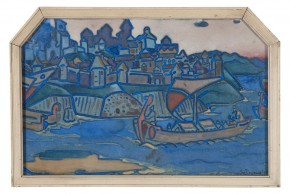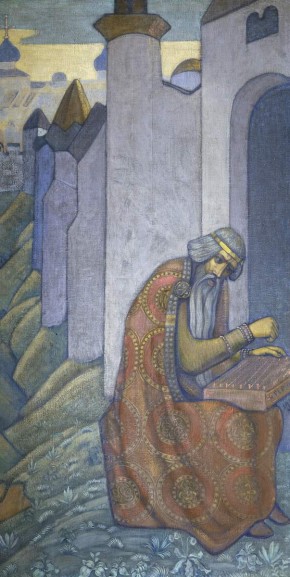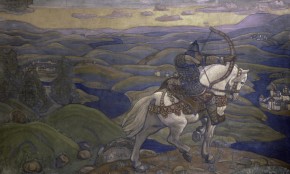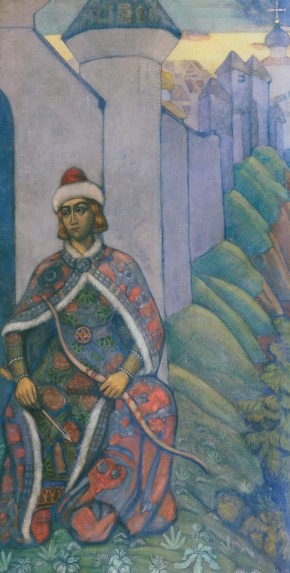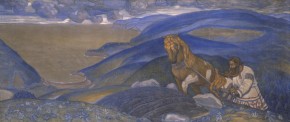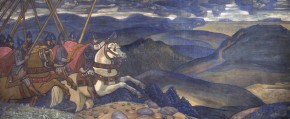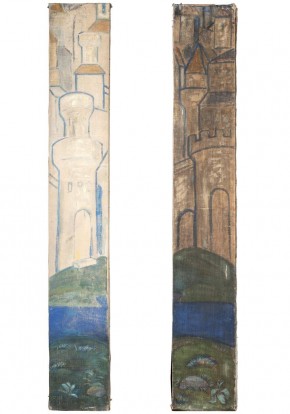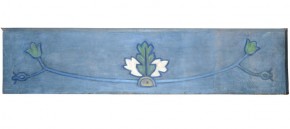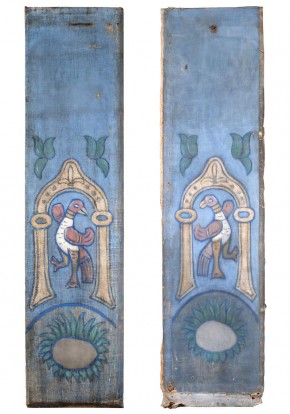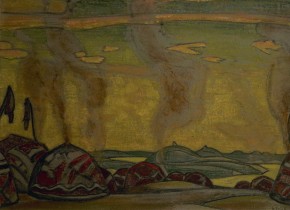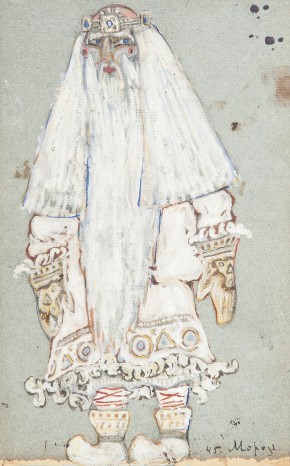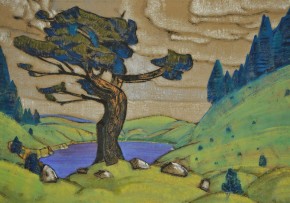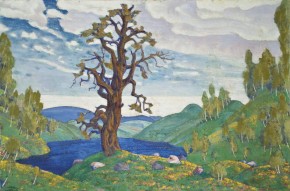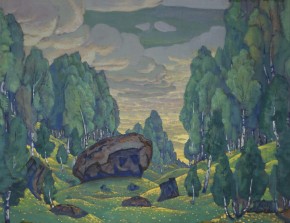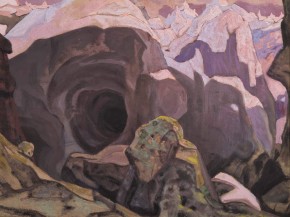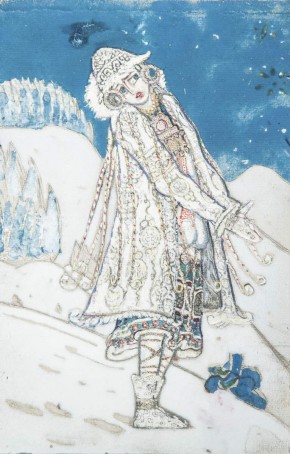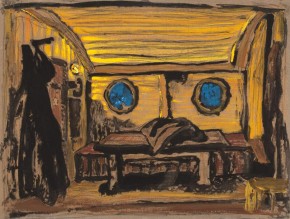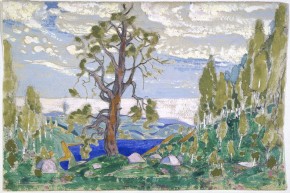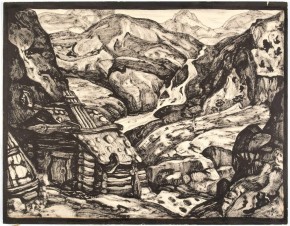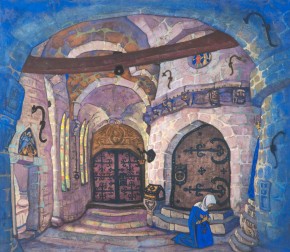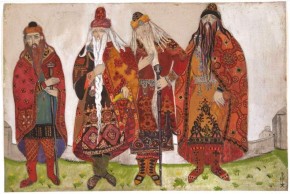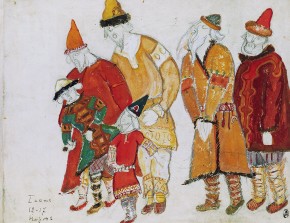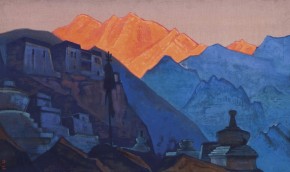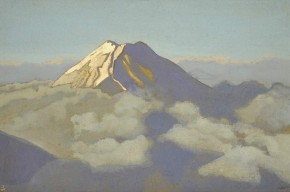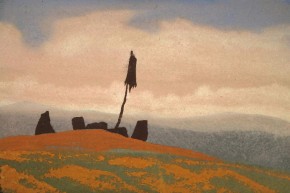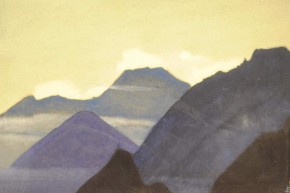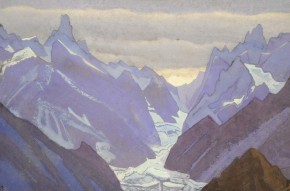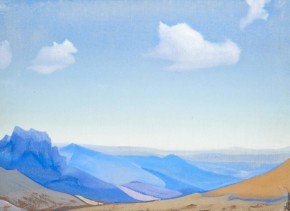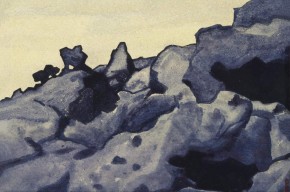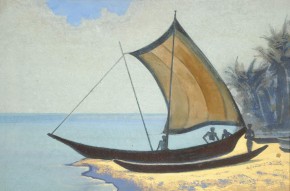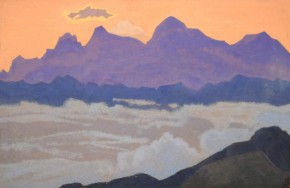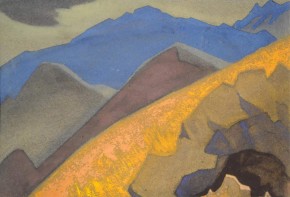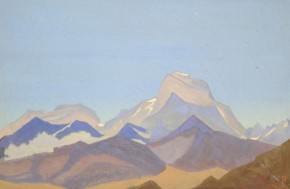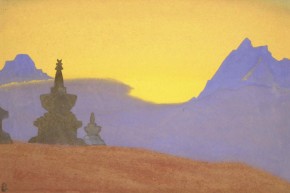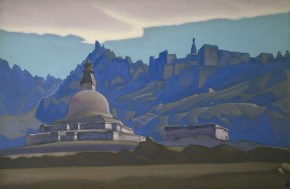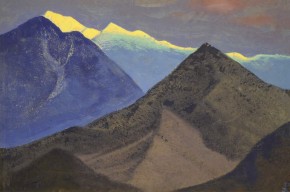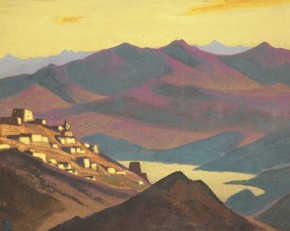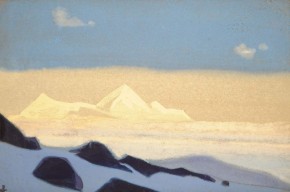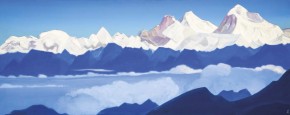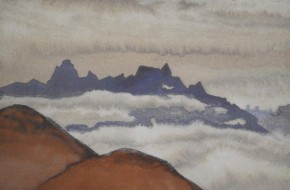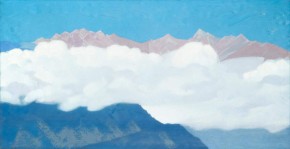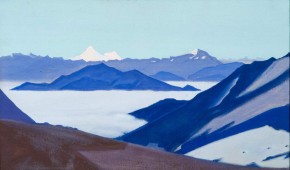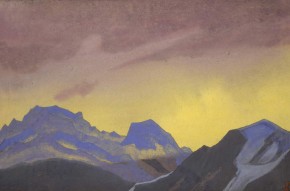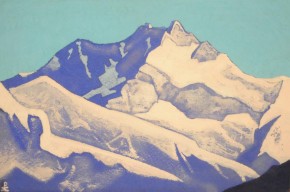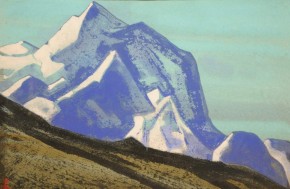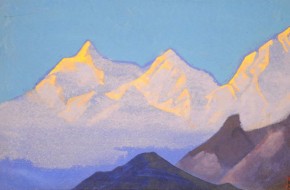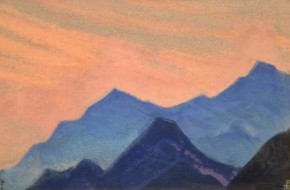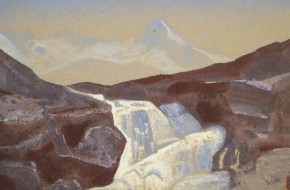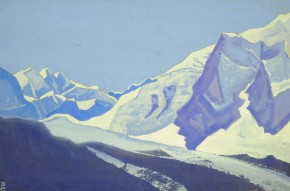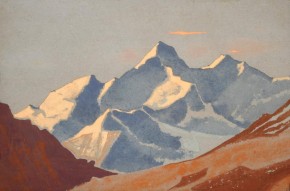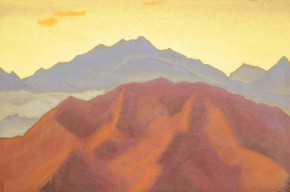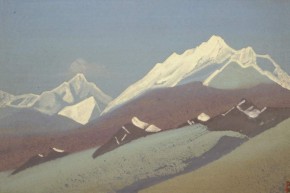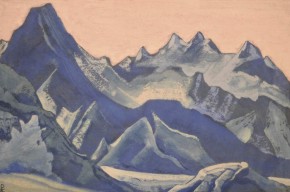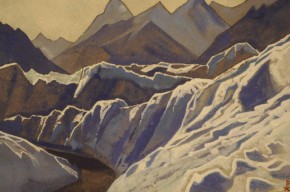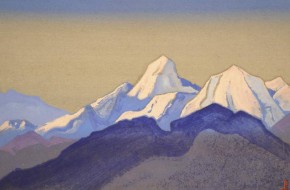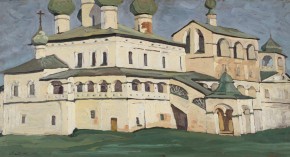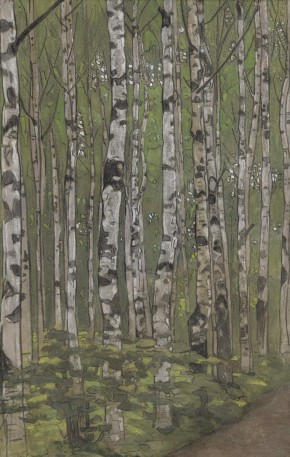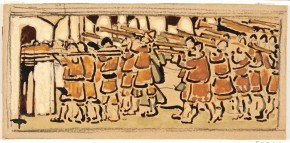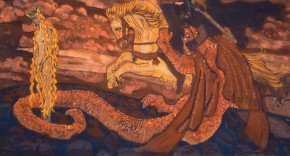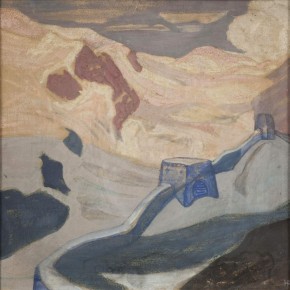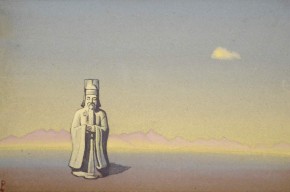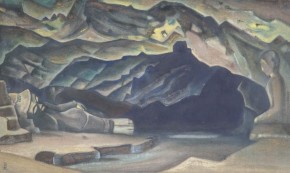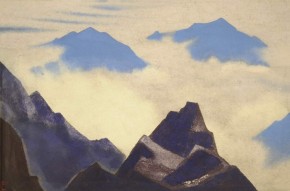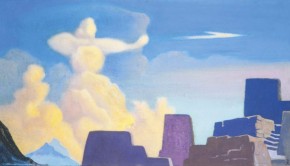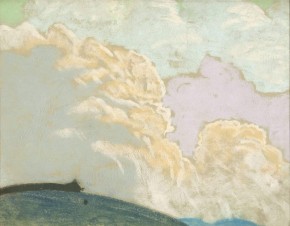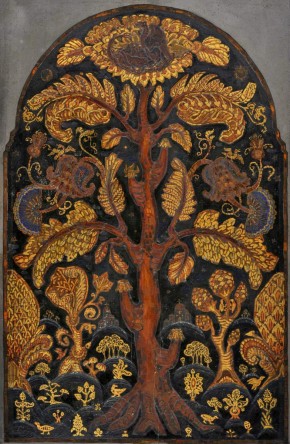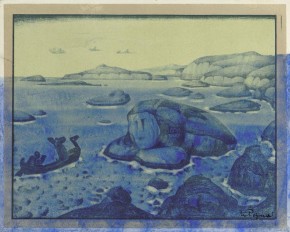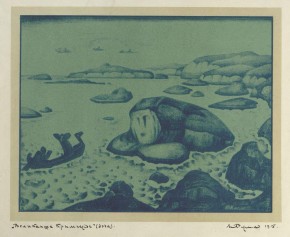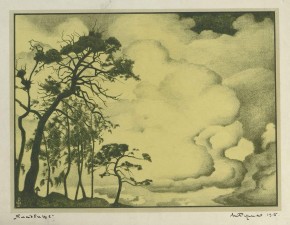Advanced search collections
Гонец (Восстал род на род)
- 1890s
- Paper, ink, nib, graphite pencil.
- The State Russian Museum
- Р-50497
The elders converge
- 1898
- Canvas, oil. 40 х 71
- The State Russian Museum
- Ж-5504
Сходятся старцы
- 1898 (?)
- сharcoal , chalk. 40,3 x 30,9
- The State Russian Museum
- Р-1943
Park in Autumn
- Study
- Early 1900s
- Canvas, oil. 36 x 56
- The State Russian Museum
- Ж-6440
Заморские гости
- 1900–1901
- gouache, ink, nib, bronze paint. 16,6 x 20,3
- The State Russian Museum
- Р-1940
Портрет князя Павла Арсеньевича Путятина (1837-1919)
- 1900
- Graphite pencil. 30,7 x 22,9
- The State Russian Museum
- Р-50518
Foreign Guests
- 1901
- Canvas, oil. 40,5 x 65
- The State Russian Museum
- Ж-1964
Idols
- 1901
- Cardboard, gouache. 49 х 56
- The State Russian Museum
- Ж-1961
Ominous
- 1901
- Canvas, oil. 104 x 233,5
- The State Russian Museum
- Ж-1958
Вещие
- 1901
- Paper, graphite pencil, watercolours. 9,2 x 22,8
- The State Russian Museum
- Р-1939
Ладьи
- 1901
- pastel. 27,6 x 27,4
- The State Russian Museum
- Р-1941
Лучник. Воины
- Paper, ink, nib, brush. 11,7 x 8,5
- The State Russian Museum
- Р-50501
Чайки
- 1901
- сharcoal , gouache, bronze paint. 22,2 x 72,9
- The State Russian Museum
- Р-50519
Idols
- 1902
- Cardboard, , watercolours. 30,8 х 26,6
- The State Russian Museum
- Р-6473
Overseas Guests
- 1902
- Cardboard, oil. 79 x 100
- The State Russian Museum
- Ж-1974
Nicholas Roerich’s Overseas Guests casts the viewer back to the romantic world of strong and brave Varangians, who, as the artist himself affirmed, introduced «a new impetus» into Russian history. The poetical structure of the canvas and its fairytale elegance contribute to the unusual nature of the history theme. The master employs several devices of Russian folk art — terse drawing and intense decorative tones. This inherent link to folk art was indicated in the catalogue of Roerich’s one-man show (1903), which lists this work as Overseas Guests. Folk Picture. The canvas was painted at Fernand Cormon’s studio in Paris, where Roerich was a student. The artist later repeated the picture for collectors. Russian Museum: From Icons to the Modern Times. Palace Editions, St Petersburg, 2015. P. 264.
Вороны
- 1902
- сharcoal , pastel.
- The State Russian Museum
- Р-57062
Замок
- Paper, ink, nib, brush. 9,8 x 14,5
- The State Russian Museum
- Р-50210
Поединок
- 1902
- Cardboard, pastel. 46,5 x 69
- The State Russian Museum
- Ж-9371
Alexander Nevsky Striking Birger Jarl
- 1904
- Cardboard, gouache. 28 х 45
- The State Russian Museum
- Ж-1960
A Novgorod chronicle tells of a battle fought on the River Neva between Russian and Swedish forces in 1240. The purpose of the Swedish attack was to seize the mouth of the river and, consequently, an area of Russian territory. In the battle the Russian forces under Prince Alexander Yaroslavich of Novgorod defeated the enemy and their leader, Birger, the future King of Sweden. Prince Alexander Yaroslavich was granted the title “Nevsky” on account of his courage and military skill.
Church of the Dormition by the Ferry in Pskov
- Early 1900s
- Canvas, oil. 53 x 79
- The State Russian Museum
- Ж-6438
Roerich Nicholas (Nikolai Konstantinovich)
1874, St Petersburg - 7, Kullu (India)Painter, theatrical designer, writer. Studied under Arkhip Kuindzhi at the Imperial Academy of Arts (1893-97), Faculty of Law, St Petersburg University (1893-98) and Fernand Cormon\'\'s studio in Paris (1900-01). Academician of painting (1909). Contributed to exhibitions (from 1895). Contributed to the exhibitions of the World of Art (1902, 1903, 191 1-17; founding member 1910; chairman 1910-13), Union of Russian Artists ( 1903-10; member from 1903), Salon d\'\'Automne (1906, 1907; member from 1906), Exposition Universelle in Paris (1900), World Exhibition in St Louis (1904), International Exhibitions in Munich (1909), Rome (1911, 1914) and Malmo (1914) and the Exhibitions of Russian Art in Paris (1906-08), Berlin (1906) and Vienna (1908). Director of the School of Drawing, Society for the Encouragement of the Arts (1906-16). Designed for theatres in Moscow and St Petersburg and Sergei Diaghilev\'\'s Saisons Russes (from 1907). Emigrated (1918). Settled in Kullu in India (1928).
Гонец (Восстал род на род)
- 1890s
- Paper, ink, nib, graphite pencil.
- The State Russian Museum
- Р-50497
The elders converge
- 1898
- Canvas, oil. 40 х 71
- The State Russian Museum
- Ж-5504
Сходятся старцы
- 1898 (?)
- сharcoal , chalk. 40,3 x 30,9
- The State Russian Museum
- Р-1943
Foreign Guests
- 1901
- Canvas, oil. 40,5 x 65
- The State Russian Museum
- Ж-1964
Idols
- 1901
- Cardboard, gouache. 49 х 56
- The State Russian Museum
- Ж-1961
Idols
- 1902
- Cardboard, , watercolours. 30,8 х 26,6
- The State Russian Museum
- Р-6473
Overseas Guests
- 1902
- Cardboard, oil. 79 x 100
- The State Russian Museum
- Ж-1974
Nicholas Roerich’s Overseas Guests casts the viewer back to the romantic world of strong and brave Varangians, who, as the artist himself affirmed, introduced «a new impetus» into Russian history. The poetical structure of the canvas and its fairytale elegance contribute to the unusual nature of the history theme. The master employs several devices of Russian folk art — terse drawing and intense decorative tones. This inherent link to folk art was indicated in the catalogue of Roerich’s one-man show (1903), which lists this work as Overseas Guests. Folk Picture. The canvas was painted at Fernand Cormon’s studio in Paris, where Roerich was a student. The artist later repeated the picture for collectors. Russian Museum: From Icons to the Modern Times. Palace Editions, St Petersburg, 2015. P. 264.
Поединок
- 1902
- Cardboard, pastel. 46,5 x 69
- The State Russian Museum
- Ж-9371
Alexander Nevsky Striking Birger Jarl
- 1904
- Cardboard, gouache. 28 х 45
- The State Russian Museum
- Ж-1960
A Novgorod chronicle tells of a battle fought on the River Neva between Russian and Swedish forces in 1240. The purpose of the Swedish attack was to seize the mouth of the river and, consequently, an area of Russian territory. In the battle the Russian forces under Prince Alexander Yaroslavich of Novgorod defeated the enemy and their leader, Birger, the future King of Sweden. Prince Alexander Yaroslavich was granted the title “Nevsky” on account of his courage and military skill.
Patrol
- 1905
- Canvas, oil. 148,5 x 148,5
- The State Russian Museum
- Ж-2003
Slavs on the Dnieper
- 1905
- Tempera, cardboard. 67 х 89
- The State Russian Museum
- Ж-1975
Городок
- 1907
- Cardboard, tempera, graphite, gouache. 15 x 23
- The State Russian Museum
- Ж-1970
Boyan (Bard)
- 1910
- Canvas, tempera. 203 х 104,5
- The State Russian Museum
- Ж-7959
Ilya Muromets
- 1910
- Canvas, tempera. 203 x 338
- The State Russian Museum
- Ж-7953
Ilya Muromets, a character from folk epics, was a bogatyr who represented the ideal of the hero and warrior.
The suite “Bogatyr Frieze”
In 1909-1910 Roerich performed the series of panels "Bogatyr frieze" for the mansion of Philadelph (Philipp) Bazhanov, the prominent industrialist and honorable citizen of Saint- Petersburg. The house was built by the architect Pavel Aleshin in 1907-1908 in the Art Nouveau style. Unique design was characteristic of every interior he created, but the theme of heroic Ancient Rus was the dominant one. The living room was decorated with majolica fireplace "Volga and Mikula", made according to the sketch of Mikhail Vrubel. The Roerich's panel was located in the dining room. The series consisted of eight narratives (“Sadko”, “Knight”,”Boyan (Bard)”, “Ilya Muromets”, “Mikula Selyaninovich”, “Hill Fort”, “Volga Svyatoslavovich”, “Nightingale the Robber”) and eleven decorative compositions. The creation of the monumental "Bogatyr frieze" became the culmination of Roerich’s appeal to the epic topic in his work.
Knight
- 1910
- Canvas, tempera. 204 x 104,5
- The State Russian Museum
- Ж-7960
Mikula Selyaninovich
- 1910
- Canvas, tempera. 203 x 494
- The State Russian Museum
- Ж-7957
Mikula Selyaninovich, a character from Russian folk epics, was a legendary bogatyr who was very good at ploughing land; he personified the Russian peasantry.
The suite “Bogatyr Frieze”
In 1909-1910 Roerich performed the series of panels "Bogatyr frieze" for the mansion of Philadelph (Philipp) Bazhanov, the prominent industrialist and honorable citizen of Saint- Petersburg. The house was built by the architect Pavel Aleshin in 1907-1908 in the Art Nouveau style. Unique design was characteristic of every interior he created, but the theme of heroic Ancient Rus was the dominant one. The living room was decorated with majolica fireplace "Volga and Mikula", made according to the sketch of Mikhail Vrubel. The Roerich's panel was located in the dining room. The series consisted of eight narratives (“Sadko”, “Knight”,”Boyan (Bard)”, “Ilya Muromets”, “Mikula Selyaninovich”, “Hill Fort”, “Volga Svyatoslavovich”, “Nightingale the Robber”) and eleven decorative compositions. The creation of the monumental "Bogatyr frieze" became the culmination of Roerich’s appeal to the epic topic in his work.
Nightingale the Robber
- 1910
- Canvas, tempera. 202 x 341
- The State Russian Museum
- Ж-7954
Nightingale the Robber was a negative character in Eastern Slav mythology and folk epics. He would perch on a tree by a road and stun anyone passing by with his terrible whistle. He could not be defeated until, according to one version of the story, the bogatyr Ilya Muromets blinded him with his sharp spear.
The suite “Bogatyr Frieze”
In 1909-1910 Roerich performed the series of panels "Bogatyr frieze" for the mansion of Philadelph (Philipp) Bazhanov, the prominent industrialist and honorable citizen of Saint- Petersburg. The house was built by the architect Pavel Aleshin in 1907-1908 in the Art Nouveau style. Unique design was characteristic of every interior he created, but the theme of heroic Ancient Rus was the dominant one. The living room was decorated with majolica fireplace "Volga and Mikula", made according to the sketch of Mikhail Vrubel. The Roerich's panel was located in the dining room. The series consisted of eight narratives (“Sadko”, “Knight”,”Boyan (Bard)”, “Ilya Muromets”, “Mikula Selyaninovich”, “Hill Fort”, “Volga Svyatoslavovich”, “Nightingale the Robber”) and eleven decorative compositions. The creation of the monumental "Bogatyr frieze" became the culmination of Roerich’s appeal to the epic topic in his work.
Sadko
- 1910
- Tempera, canvas. 203 х 700
- The State Russian Museum
- Ж-7958
Volga Svyatoslavovich
- 1910
- Canvas, tempera. 203 x 495
- The State Russian Museum
- Ж-7956
Volga Svyatoslavovich was a character from Russian folk epics. He was a bogatyr, a hunter and a warrior, and was able to transform himself into various wild animals.
The suite “Bogatyr Frieze”
In 1909-1910 Roerich performed the series of panels "Bogatyr frieze" for the mansion of Philadelph (Philipp) Bazhanov, the prominent industrialist and honorable citizen of Saint- Petersburg. The house was built by the architect Pavel Aleshin in 1907-1908 in the Art Nouveau style. Unique design was characteristic of every interior he created, but the theme of heroic Ancient Rus was the dominant one. The living room was decorated with majolica fireplace "Volga and Mikula", made according to the sketch of Mikhail Vrubel. The Roerich's panel was located in the dining room. The series consisted of eight narratives (“Sadko”, “Knight”,”Boyan (Bard)”, “Ilya Muromets”, “Mikula Selyaninovich”, “Hill Fort”, “Volga Svyatoslavovich”, “Nightingale the Robber”) and eleven decorative compositions. The creation of the monumental "Bogatyr frieze" became the culmination of Roerich’s appeal to the epic topic in his work.
Архитектурный мотив
- 1910
- Canvas, tempera. 140 x 20
- The State Russian Museum
- Ж-7964-Ж-7965
Boyan (Bard)
- 1910
- Canvas, tempera. 203 х 104,5
- The State Russian Museum
- Ж-7959
Ilya Muromets
- 1910
- Canvas, tempera. 203 x 338
- The State Russian Museum
- Ж-7953
Ilya Muromets, a character from folk epics, was a bogatyr who represented the ideal of the hero and warrior.
The suite “Bogatyr Frieze”
In 1909-1910 Roerich performed the series of panels "Bogatyr frieze" for the mansion of Philadelph (Philipp) Bazhanov, the prominent industrialist and honorable citizen of Saint- Petersburg. The house was built by the architect Pavel Aleshin in 1907-1908 in the Art Nouveau style. Unique design was characteristic of every interior he created, but the theme of heroic Ancient Rus was the dominant one. The living room was decorated with majolica fireplace "Volga and Mikula", made according to the sketch of Mikhail Vrubel. The Roerich's panel was located in the dining room. The series consisted of eight narratives (“Sadko”, “Knight”,”Boyan (Bard)”, “Ilya Muromets”, “Mikula Selyaninovich”, “Hill Fort”, “Volga Svyatoslavovich”, “Nightingale the Robber”) and eleven decorative compositions. The creation of the monumental "Bogatyr frieze" became the culmination of Roerich’s appeal to the epic topic in his work.
Knight
- 1910
- Canvas, tempera. 204 x 104,5
- The State Russian Museum
- Ж-7960
Mikula Selyaninovich
- 1910
- Canvas, tempera. 203 x 494
- The State Russian Museum
- Ж-7957
Mikula Selyaninovich, a character from Russian folk epics, was a legendary bogatyr who was very good at ploughing land; he personified the Russian peasantry.
The suite “Bogatyr Frieze”
In 1909-1910 Roerich performed the series of panels "Bogatyr frieze" for the mansion of Philadelph (Philipp) Bazhanov, the prominent industrialist and honorable citizen of Saint- Petersburg. The house was built by the architect Pavel Aleshin in 1907-1908 in the Art Nouveau style. Unique design was characteristic of every interior he created, but the theme of heroic Ancient Rus was the dominant one. The living room was decorated with majolica fireplace "Volga and Mikula", made according to the sketch of Mikhail Vrubel. The Roerich's panel was located in the dining room. The series consisted of eight narratives (“Sadko”, “Knight”,”Boyan (Bard)”, “Ilya Muromets”, “Mikula Selyaninovich”, “Hill Fort”, “Volga Svyatoslavovich”, “Nightingale the Robber”) and eleven decorative compositions. The creation of the monumental "Bogatyr frieze" became the culmination of Roerich’s appeal to the epic topic in his work.
Nightingale the Robber
- 1910
- Canvas, tempera. 202 x 341
- The State Russian Museum
- Ж-7954
Nightingale the Robber was a negative character in Eastern Slav mythology and folk epics. He would perch on a tree by a road and stun anyone passing by with his terrible whistle. He could not be defeated until, according to one version of the story, the bogatyr Ilya Muromets blinded him with his sharp spear.
The suite “Bogatyr Frieze”
In 1909-1910 Roerich performed the series of panels "Bogatyr frieze" for the mansion of Philadelph (Philipp) Bazhanov, the prominent industrialist and honorable citizen of Saint- Petersburg. The house was built by the architect Pavel Aleshin in 1907-1908 in the Art Nouveau style. Unique design was characteristic of every interior he created, but the theme of heroic Ancient Rus was the dominant one. The living room was decorated with majolica fireplace "Volga and Mikula", made according to the sketch of Mikhail Vrubel. The Roerich's panel was located in the dining room. The series consisted of eight narratives (“Sadko”, “Knight”,”Boyan (Bard)”, “Ilya Muromets”, “Mikula Selyaninovich”, “Hill Fort”, “Volga Svyatoslavovich”, “Nightingale the Robber”) and eleven decorative compositions. The creation of the monumental "Bogatyr frieze" became the culmination of Roerich’s appeal to the epic topic in his work.
Sadko
- 1910
- Tempera, canvas. 203 х 700
- The State Russian Museum
- Ж-7958
Volga Svyatoslavovich
- 1910
- Canvas, tempera. 203 x 495
- The State Russian Museum
- Ж-7956
Volga Svyatoslavovich was a character from Russian folk epics. He was a bogatyr, a hunter and a warrior, and was able to transform himself into various wild animals.
The suite “Bogatyr Frieze”
In 1909-1910 Roerich performed the series of panels "Bogatyr frieze" for the mansion of Philadelph (Philipp) Bazhanov, the prominent industrialist and honorable citizen of Saint- Petersburg. The house was built by the architect Pavel Aleshin in 1907-1908 in the Art Nouveau style. Unique design was characteristic of every interior he created, but the theme of heroic Ancient Rus was the dominant one. The living room was decorated with majolica fireplace "Volga and Mikula", made according to the sketch of Mikhail Vrubel. The Roerich's panel was located in the dining room. The series consisted of eight narratives (“Sadko”, “Knight”,”Boyan (Bard)”, “Ilya Muromets”, “Mikula Selyaninovich”, “Hill Fort”, “Volga Svyatoslavovich”, “Nightingale the Robber”) and eleven decorative compositions. The creation of the monumental "Bogatyr frieze" became the culmination of Roerich’s appeal to the epic topic in his work.
Архитектурный мотив
- 1910
- Canvas, tempera. 140 x 20
- The State Russian Museum
- Ж-7964-Ж-7965
Городище
- 1910
- Canvas, tempera. 65 x 474
- The State Russian Museum
- Ж-7955
Растительный мотив
- 1910
- Canvas, tempera. 35 x 145
- The State Russian Museum
- Ж-7962
Растительный мотив с птицей
- 1910
- Canvas, tempera. 138 x 33
- The State Russian Museum
- Ж-7967-Ж-7969
Polovtsian Camp
- Set design for the production of the Polovtsian Dances from Alexander Borodin’s opera Prince Igor in Paris during Saisons Russes (1909)
- 1909
- Cardboard, pastel, tempera. 43 х 60
- The State Russian Museum
- Ж-1983
Battle of Kerzhenets
- Study
- 1911
- Cardboard, tempera. 52,5 x 70
- The State Russian Museum
- Ж-10994
Battle of Kerzhenets is a curtain design by Roerich for a symphonic interlude in Rimsky-Korsakov’s opera The Legend of the Invisible City of Kitezh and the Maiden Fevronia for Sergei Diaghilev’s Saisons Russes in Paris. The Battle of Kerzhenets is an episode in the Russian forces’ battle against the invading Tartars in the 13th century. According to legend in this battle an entire town, called Kitezh, vanished into the waters of the River Kerzhenets which flows through the Nizhny Novgorod Province. In his curtain design Roerich depicted the fierce battle between the Russians and the Tartars. The swiftly galloping riders and ominously swirling clouds reflected in the waters of the river hide the outlines of the vanishing town, thus saving it from destruction by the enemy. Later on the design would form the basis of a decorative panel for the Kazan Station in Moscow (it was never produced).
Grandfather Frost
- 1912
- Paper, tempera, graphite, gouache. 24 x 15,5
- The State Russian Museum
- Ж-1969
Set and costume designs for the production of Alexander Ostrovsky’s play The Snow Maiden at the Reineke Dramatic Theater in St Petersburg.
Николай Рерих. В поисках Шамбалы. СПб, 2020. С. 62.
Kiss the Earth
- Set design for the production of Igor Stravinsky’s ballet The Rite of Spring in Paris during Saisons Russes (1913)
- 1912
- Cardboard, tempera. 56 х 80,5
- The State Russian Museum
- Ж-1982
Set design for Act I of Igor Stravinsky’s ballet Le Sacre du printemps Sergei Diaghilev’s Ballets Russes. Paris, 1913
The artist himself contributed to the libretto of Igor Stravinsky’s ballet Le Sacre du printemps. While Stravinsky composed the music, Roerich developed the ballet “score”, employing his excellent knowledge of the customs, dances and costumery of the Ancient Slavs in a synthesis of the arts befitting a member of the World of Art. Although his sets were highly acclaimed by the critics, the public failed to understand the revolutionary choreography of Vaslav Nijinsky. Audiences whistled and jeered, drowning out the orchestra. Adoration of the Earth is inspired by ancient Russian history.
Kiss the Earth. First Act
- Set design for the production of Igor Stravinsky’s ballet The Rite of Spring in Paris during Saisons Russes (1913)
- 1912
- Cardboard, tempera. 62 x 94
- The State Russian Museum
- Ж-1979
Mountainous Area
- Third Act
- 1912
- Cardboard, tempera, graphite, gouache. 56 x 70
- The State Russian Museum
- Ж-1967
Romsdal Cliffs
- Set designs for the production of Henrik Ibsen’s drama Peer Gynt at the Moscow Art Theater. 1912. Second Act
- 1912
- Cardboard, tempera. 66 x 87
- The State Russian Museum
- Ж-5501
Snow Maiden
- 1912
- Paper, tempera, graphite, gouache. 24,5 x 15,5
- The State Russian Museum
- Ж-1968
Set and costume designs for the production of Alexander Ostrovsky’s play The Snow Maiden at the Reineke Dramatic Theater in St Petersburg 1912.
Николай Рерих. В поисках Шамбалы. СПб, 2020. С. 62.
Каюта
- 1912 (?)
- Tempera, сharcoal . 52 x 69,1
- The State Russian Museum
- Р-57518
Поцелуй Земле
- 1912
- Paper, watercolours, white pigment, graphite pencil, tempera. 17 x 25,5
- The State Russian Museum
- Р-57591
Декорация к I акту Пер-Гюнта
- 1913
- Paper, ink. 48,4 x 64,1
- The State Russian Museum
- Р-1936
In the Convent
- Set design for the production of Alexei Davidov’s opera Sister Beatrice, based on the play of the same name by Maurice Maeterlinck, performed at the Musical Drama Theater in Petrograd in 1915
- 1914
- Cardboard, tempera. 75,5 х 86
- The State Russian Museum
- Ж-1981
Бояре
- 1914
- paper mounted on cardboard, gouache, ink, , graphite pencil. 32,1 х 48,2
- The State Russian Museum
- Р-57592
Народ
- 1914
- Paper, gouache, graphite pencil. 26,7 x 33,4
- The State Russian Museum
- Р-1938
Скула и Ерошка
- 1914
- Paper, gouache, graphite pencil. 26,8 x 33,4
- The State Russian Museum
- Р-1937
Tibet. Burning Mountaintop
- 1933 (?)
- Canvas, tempera. 46 x 79
- The State Russian Museum
- Ж-7078
Fujiyama
- 1935 (6?)
- Cardboard, tempera. 30,6 x 45,7
- The State Russian Museum
- Ж-7315
Fujiyama
- 1935 (6?)
- Cardboard, tempera. 30,8 x 46,1
- The State Russian Museum
- Ж-7223
Fujiyama
- 1935 (6?)
- Cardboard, tempera. 30,6 x 45,8
- The State Russian Museum
- Ж-7136
Lahaul Rocks (Signs ofGesar)
- 1935
- Canvas, tempera. 86 x 123
- The State Russian Museum
- Ж-7106
Images of this sort are typical of Bronze Age rock paintings discovered in India, Kirgizia, Kazakhstan, Mongolia and Western Tibet (Lahaul). The images depict the traditional scene of a round dance in honour of the god Gesar. Roerich returned several times to this character both in his paintings and his writings (The Sword of Gesar Khan). Gesar Khan was a religious hero in a Mongolian-Tibetan epic who cleansed the earth of monsters.
Гуннская могила
- 1935 (6?)
- Cardboard, tempera, graphite, gouache. 30,5 x 45,7
- The State Russian Museum
- Ж-7152
Кулута (Горы перед рассветом)
- 1935 (6?)
- Cardboard, tempera, graphite, gouache. 30,7 x 45,8
- The State Russian Museum
- Ж-7310
Ледник Лахул
- 1935 (6?)
- Cardboard, tempera. 30,9 x 45,8
- The State Russian Museum
- Ж-7213
Наран-Обо. Монголия
- 1935 (6?)
- Canvas, tempera. 48 x 63,5
- The State Russian Museum
- Ж-7083
Пещеры Баин-Обо. Монголия
- 1935 (6?)
- Cardboard, tempera, graphite, gouache. 30,8 x 45,8
- The State Russian Museum
- Ж-7108
Цейлон (Парусная лодка на песке)
- 1935 (6?)
- Cardboard, tempera, graphite, gouache. 30,5 x 45,6
- The State Russian Museum
- Ж-7215
Эверест (Джомолунгма)
- 1935 (6?)
- Cardboard, tempera, graphite, gouache. 30,3 x 45,5
- The State Russian Museum
- Ж-7168
Золотой склон
- Cardboard, tempera, graphite, gouache. 30,7 x 49,5
- The State Russian Museum
- Ж-7411
Предрассветные горы
- Cardboard, tempera, graphite, gouache. 30,7 x 45,6
- The State Russian Museum
- Ж-7291
Evening (Stupas at Blue Mountains)
- 1937
- Cardboard, tempera. 30,8 x 45,8
- The State Russian Museum
- Ж-7159
Stupa. Ladakh
- 1937
- Canvas, tempera. 82 x 123
- The State Russian Museum
- Ж-7105
Tibet (Dark Mountaintops at Evening)
- 1937
- Cardboard, tempera. 30,5 x 45,7
- The State Russian Museum
- Ж-7203
Yamdrok Lake (A Settlement in the Mountains)
- 1937
- Cardboard, tempera, graphite, gouache. 30,5 х 37,7
- The State Russian Museum
- Ж-7149
Вечерние горы
- 1937
- Cardboard, tempera. 30,6 x 45,8
- The State Russian Museum
- Ж-7319
Граница Тибета (Снежное пространство)
- 1937
- Cardboard, tempera, graphite, gouache. 30,5 x 45,8
- The State Russian Museum
- Ж-7369
Himalayas. Rakaposhi
- 1933
- Canvas, tempera. 46 x 79
- The State Russian Museum
- Ж-7075
Rakaposhi is a 7,788 metre peak.
Николай Рерих. В поисках Шамбалы. Каталог выставки в Малаге. 2019. С. 74.
Everest (Jomolungma)
- 1935
- Canvas, tempera. 61 x 152
- The State Russian Museum
- Ж-7099
Гималаи. Туман
- 1935 (6?)
- Cardboard, tempera, graphite, gouache. 30,2 x 45,7
- The State Russian Museum
- Ж-7151
Облака на вершинах. Гималаи
- Canvas, tempera. 31 x 61
- The State Russian Museum
- Ж-7084
Туман в горах. Гималаи
- Canvas, tempera. 46 x 79
- The State Russian Museum
- Ж-7076
Himalayas. Blue Cliffs
- 1937
- Cardboard, tempera. 30,7 x 45,9
- The State Russian Museum
- Ж-7128
Вершина Канченджанги (Снежные вершины на бирюзовом небе)
- 1937
- Cardboard, tempera. 30,3 x 45,6
- The State Russian Museum
- Ж-7271
Гималаи (Вершины на бирюзовом небе)
- 1937
- Cardboard, tempera, graphite, gouache. 30,6 x 45,6
- The State Russian Museum
- Ж-7272
Гималаи (Лиловеющие горы)
- 1937
- Cardboard, tempera, graphite, gouache. 30,5 x 45,7
- The State Russian Museum
- Ж-7195
Гималаи (Синие скалы на розовом небе)
- 1937
- Cardboard, tempera, graphite, gouache. 30,3 x 45,6
- The State Russian Museum
- Ж-7312
Гималаи. Водопад
- 1937
- Cardboard, tempera, graphite, gouache. 30,3 x 45,5
- The State Russian Museum
- Ж-7196
Гималаи. Восход солнца
- 1937
- Cardboard, tempera, graphite, gouache. 30,5 x 45,8
- The State Russian Museum
- Ж-7189
Гималаи. Голубая гряда
- 1937
- Cardboard, tempera, graphite, gouache. 30,8 x 46,2
- The State Russian Museum
- Ж-7176
Нанда-Деви (Горная цепь на закате)
- 1937
- Cardboard, tempera, graphite, gouache. 30,5 x 45,6
- The State Russian Museum
- Ж-7180
Сандахпу (Оранжевые облака над лиловыми скалами)
- 1937
- Cardboard, tempera, graphite, gouache. 30,9 x 46
- The State Russian Museum
- Ж-7143
Himalayas (Albescent Mountaintops)
- 1938
- Cardboard, tempera. 30,5 x 45,7
- The State Russian Museum
- Ж-7348
Himalayas (Blue Mountain - tops at Dawn)
- 1938
- Cardboard, tempera. 30,7 x 45,7
- The State Russian Museum
- Ж-7266
Himalayas (Ice-Covered Slopes)
- 1938
- Cardboard, tempera. 30 x 45,5
- The State Russian Museum
- Ж-7174
Himalayas (Mountaintops Illuminated by the Sun)
- 1938
- Cardboard, tempera. 30,7 x 45,8
- The State Russian Museum
- Ж-7199
Himalayas (Towering Mountaintops)
- 1938
- Cardboard, tempera. 30,6 x 45,8
- The State Russian Museum
- Ж-7277
Гонец (Восстал род на род)
- 1890s
- Paper, ink, nib, graphite pencil.
- The State Russian Museum
- Р-50497
Park in Autumn
- Study
- Early 1900s
- Canvas, oil. 36 x 56
- The State Russian Museum
- Ж-6440
Заморские гости
- 1900–1901
- gouache, ink, nib, bronze paint. 16,6 x 20,3
- The State Russian Museum
- Р-1940
Портрет князя Павла Арсеньевича Путятина (1837-1919)
- 1900
- Graphite pencil. 30,7 x 22,9
- The State Russian Museum
- Р-50518
Ominous
- 1901
- Canvas, oil. 104 x 233,5
- The State Russian Museum
- Ж-1958
Вещие
- 1901
- Paper, graphite pencil, watercolours. 9,2 x 22,8
- The State Russian Museum
- Р-1939
Ладьи
- 1901
- pastel. 27,6 x 27,4
- The State Russian Museum
- Р-1941
Лучник. Воины
- Paper, ink, nib, brush. 11,7 x 8,5
- The State Russian Museum
- Р-50501
Чайки
- 1901
- сharcoal , gouache, bronze paint. 22,2 x 72,9
- The State Russian Museum
- Р-50519
Вороны
- 1902
- сharcoal , pastel.
- The State Russian Museum
- Р-57062
Замок
- Paper, ink, nib, brush. 9,8 x 14,5
- The State Russian Museum
- Р-50210
Church of the Dormition by the Ferry in Pskov
- Early 1900s
- Canvas, oil. 53 x 79
- The State Russian Museum
- Ж-6438
Monastery of the Resurrection in Uglich
- 1904
- Wood, oil. 46 x 83
- The State Russian Museum
- Ж-1977
Stone Age. North. Walrus Hunt
- 1904
- Cardboard, gouache. 12 x 62
- The State Russian Museum
- Ж-1987
Каменный век. Север. Олени
- 1904
- Cardboard, gouache. 12 x 62
- The State Russian Museum
- Ж-1986
Birch Trees
- 1905
- Paper, pastel, tempera, graphite. 51 х 33
- The State Russian Museum
- Ж-1959
Возвращение с охоты
- 1900s
- Graphite and coloured pencils. 20,2 x 26,1
- The State Russian Museum
- Р-50525
На приступ
- paper mounted on cardboard, watercolours, white pigment, oil. 7,8 x 16,6
- The State Russian Museum
- Р-50209
The Serpent Princess
- 1906
- Cardboard, tempera. 50 х 39
- The State Russian Museum
- Ж-1962
One of the demonic motifs that fascinated artists in the middle of the 1900s. He was inspired by the little-known and evidently very ancient subject of half-men/half-serpents, which resembles a tortuous dream about the irresistible power of love. The phosphorescent paints, clouds racing across the sky and the flapping cape of the hero here are contrasted with hardened, lubok-esque "primitive" figures that convey the meaning of the scene, a scene full of "terrible charms and the murmurings of quiet horror".
Стена в горах
- 1906
- Cardboard, tempera, graphite, gouache. 47,2 x 47,2
- The State Russian Museum
- Ж-1992
Tibet. Burning Mountaintop
- 1933 (?)
- Canvas, tempera. 46 x 79
- The State Russian Museum
- Ж-7078
Arhat
- 1935(6?)
- Cardboard, tempera. 30,9 х 45,8
- The State Russian Museum
- Ж-7155
Everest (Jomolungma)
- 1935
- Canvas, tempera. 61 x 152
- The State Russian Museum
- Ж-7099
Fujiyama
- 1935 (6?)
- Cardboard, tempera. 30,6 x 45,7
- The State Russian Museum
- Ж-7315
Fujiyama
- 1935 (6?)
- Cardboard, tempera. 30,8 x 46,1
- The State Russian Museum
- Ж-7223
Fujiyama
- 1935 (6?)
- Cardboard, tempera. 30,6 x 45,8
- The State Russian Museum
- Ж-7136
Lahaul Rocks (Signs ofGesar)
- 1935
- Canvas, tempera. 86 x 123
- The State Russian Museum
- Ж-7106
Images of this sort are typical of Bronze Age rock paintings discovered in India, Kirgizia, Kazakhstan, Mongolia and Western Tibet (Lahaul). The images depict the traditional scene of a round dance in honour of the god Gesar. Roerich returned several times to this character both in his paintings and his writings (The Sword of Gesar Khan). Gesar Khan was a religious hero in a Mongolian-Tibetan epic who cleansed the earth of monsters.
Parinirvana
- 1935 (6?)
- Canvas, tempera. 47 x 79
- The State Russian Museum
- Ж-7077
Гуннская могила
- 1935 (6?)
- Cardboard, tempera, graphite, gouache. 30,5 x 45,7
- The State Russian Museum
- Ж-7152
Кулута (Горы перед рассветом)
- 1935 (6?)
- Cardboard, tempera, graphite, gouache. 30,7 x 45,8
- The State Russian Museum
- Ж-7310
Ледник Лахул
- 1935 (6?)
- Cardboard, tempera. 30,9 x 45,8
- The State Russian Museum
- Ж-7213
Наран-Обо. Монголия
- 1935 (6?)
- Canvas, tempera. 48 x 63,5
- The State Russian Museum
- Ж-7083
Цейлон (Парусная лодка на песке)
- 1935 (6?)
- Cardboard, tempera, graphite, gouache. 30,5 x 45,6
- The State Russian Museum
- Ж-7215
Эверест (Джомолунгма)
- 1935 (6?)
- Cardboard, tempera, graphite, gouache. 30,3 x 45,5
- The State Russian Museum
- Ж-7168
Золотой склон
- Cardboard, tempera, graphite, gouache. 30,7 x 49,5
- The State Russian Museum
- Ж-7411
Предрассветные горы
- Cardboard, tempera, graphite, gouache. 30,7 x 45,6
- The State Russian Museum
- Ж-7291
Cliffs of Lahaul
- 1937
- Cardboard, tempera. 30,7 x 45,7
- The State Russian Museum
- Ж-7352
Defender (Cloud-Marksman)
- 1937
- Cardboard, tempera. 46 x 79
- The State Russian Museum
- Ж-7073
Evening (Stupas at Blue Mountains)
- 1937
- Cardboard, tempera. 30,8 x 45,8
- The State Russian Museum
- Ж-7159
Stupa. Ladakh
- 1937
- Canvas, tempera. 82 x 123
- The State Russian Museum
- Ж-7105
Гонец (Восстал род на род)
- 1890s
- Paper, ink, nib, graphite pencil.
- The State Russian Museum
- Р-50497
Сходятся старцы
- 1898 (?)
- сharcoal , chalk. 40,3 x 30,9
- The State Russian Museum
- Р-1943
Портрет князя Павла Арсеньевича Путятина (1837-1919)
- 1900
- Graphite pencil. 30,7 x 22,9
- The State Russian Museum
- Р-50518
Вещие
- 1901
- Paper, graphite pencil, watercolours. 9,2 x 22,8
- The State Russian Museum
- Р-1939
Ладьи
- 1901
- pastel. 27,6 x 27,4
- The State Russian Museum
- Р-1941
Лучник. Воины
- Paper, ink, nib, brush. 11,7 x 8,5
- The State Russian Museum
- Р-50501
Чайки
- 1901
- сharcoal , gouache, bronze paint. 22,2 x 72,9
- The State Russian Museum
- Р-50519
Вороны
- 1902
- сharcoal , pastel.
- The State Russian Museum
- Р-57062
Замок
- Paper, ink, nib, brush. 9,8 x 14,5
- The State Russian Museum
- Р-50210
На приступ
- paper mounted on cardboard, watercolours, white pigment, oil. 7,8 x 16,6
- The State Russian Museum
- Р-50209
Каюта
- 1912 (?)
- Tempera, сharcoal . 52 x 69,1
- The State Russian Museum
- Р-57518
Облака
- Paper, pastel. 24,5 x 31,7
- The State Russian Museum
- Р-50213
Древо жизни
- 1913
- Cardboard, gouache, ink, bronze paint, graphite pencil. 65 x 45,3
- The State Russian Museum
- Р-35604
Бояре
- 1914
- paper mounted on cardboard, gouache, ink, , graphite pencil. 32,1 х 48,2
- The State Russian Museum
- Р-57592
Народ
- 1914
- Paper, gouache, graphite pencil. 26,7 x 33,4
- The State Russian Museum
- Р-1938
Скула и Ерошка
- 1914
- Paper, gouache, graphite pencil. 26,8 x 33,4
- The State Russian Museum
- Р-1937
Великанша
- 1915
- Paper, lithography, watercolours.
- The State Russian Museum
- Гр.-27528
Великанша Кримгерд
- 1915
- Paper, ink, watercolours. 20,1 x 26,7
- The State Russian Museum
- Р-50515
Великанша Кримгерд (Эдда)
- 1915
- Paper, .
- The State Russian Museum
- Гр.-41901
Кладбище
- 1915
- Paper, .
- The State Russian Museum
- Гр.-41900
